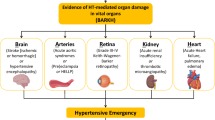Abstract
Beta-blockers are a highly promising treatment modality for complicated infantile hemangiomas (IH). However, data on propranolol as first-line treatment, objective outcome measures and impact on hemodynamics in young infants is limited. We retrospectively evaluated a homogenous group of infants with proliferating complicated IH treated with propranolol (2 mg/kg/day). Outcome was assessed by blinded evaluation of clinical photographs by visual analogue scale (VAS), ultrasound examination and ophthalmological review (if appropriate). Tolerance and hemodynamic variables were recorded over time, including a 2-day in-patient observation at the initiation of therapy. Twenty-five infants (median age 3.6 (1.5–9.1) months) were included in the study. The median follow-up-time was 14 (9–20) months and 14 patients completed treatment at a median age of 14.3 (11.4–22.1) months, after a duration of 10.5 (7.5–16) months. In all patients, there was significant fading of colour (with a VAS of −9 (−6 to −9) after 7 months) and significant decrease in size of the IH (with a VAS of −8 (−3 to −10) after 7 months). Median thickness of the lesions assessed by ultrasound at baseline and after 1 month was 14 (7–28) mm and 10 (5–23) mm, respectively (p < 0.01). In children with periocular involvement, astigmatism and amblyopia resolved rapidly within 8 weeks. The overall tolerance of propranolol was good, and no relevant hemodynamic changes were noted. Conclusion: Our report supports the excellent effect and good tolerance of this novel therapy, and we propose the use of propranolol as first-line treatment for IH.





Similar content being viewed by others
References
Bennett ML, Fleischer AB Jr, Chamlin SL, Frieden IJ (2001) Oral corticosteroid use is effective for cutaneous hemangiomas: an evicence-based evaluation. Arch Dermatol 137:1208–1213
Bruckner AL, Frieden IJ (2003) Hemangiomas of infancy. J Am Acad Dermatol 48:477–493
Buckmiller LM, Munson PD, Dyamenahalli U et al (2010) Propranolol for infantile hemangiomas: early experience at a tertiary vascular anomalies center. Laryngoscope 120:676–681
Garin EH, Araya CE (2009) Treatment of systemic hypertension in children and adolescents. Curr Opin Pediatr 21:600–604
Haggstrom AN, Drolet BA, Baselga E et al (2006) Prospective study of infantile hemangiomas: clinical characteristics predicting complications and treatment. Pediatrics 118:882–887
Haggstrom AN, Drolet BA, Baselga E et al (2007) Prospective study of infantile hemangiomas: demographic, prenatal, and perinatal characteristics. J Pediatr 150:291–294
Holland KE, Frieden IJ, Frommelt PC et al (2010) Hypoglycaemia in children taking propranolol for the treatment of infantile hemangioma. Arch Dermatol 146:775–778
Kent AL, Kecskes Z, Shadbolt B, Falk MC (2007) Blood pressure in the first year of life in healthy infants born at term. Pediatr Nephrol 22:1743–1749
Kilcline C, Frieden IJ (2008) Infantile hemangiomas: how common are they? a systematic review of the medical literature. Pediatr Dermatol 25:168–173
Laforgia N, Milano A, De Leo E, Bonifazi E (2009) Hemangioma and propranolol. Some remarks at the end of treatment. Differences from corticosteroids. Eur J Pediat Dermatol 19:175–191
Lawley LP, Siegfried E, Todd JL (2009) Propranolol treatment for hemangioma of infancy: risks and recommendations. Pediatr Dermatol 26:610–614
Léauté-Labrèze C, Dumas de la Roque E, Hubiche T et al (2008) Propranolol for severe hemangiomas of infancy. N Engl J Med 358:2649–2651
Love JN, Sikka N (2004) Are 1–2 tablets dangerous? beta-blocker exposure in toddlers. J Emerg Med 26:309–314
Manunza F, Syed S, Laguda B et al (2010) Propranolol for complicated infantile haemangiomas: a case series of 30 infants. Br J Dermatol 162:466–468
Michaud AP, Baumann NM, Burke DK et al (2004) Spastic diplegia and other motor disturbances in infants receiving interferon-alpha. Laryngoscope 114:1231–1236
National High Blood Pressure Education Program Working Group on High Blood Pressure in Children and Adolescents (2004) The fourth report on the diagnosis, evaluation, and treatment of high blood pressure in children and adolescents. Pediatrics 114:555–576
Qin ZP, Liu XJ, Li KL et al (2009) Treatment of infantile hemangiomas with low-dose propranolol: evaluation of short-term efficacy and safety. Zhonghua Yi Xue Za Zhi 89:3230–3234
Sans V, Dumas de la Roque E, Berge J et al (2009) Propranolol for severe infantile hemangiomas: follow up-report. Pediatrics 124:423–431
Storch CH, Hoeger PH (2010) Propranolol for infantile haemangiomas—insights into the molecular mechanisms of action. Br J Dermatol 163:269–274
Acknowledgments
We thank Valérie Jaquet and Gabriela Acklin (Photographers, University Children’s Hospital) for performing the photographic documentation of this study. We gratefully acknowledge Dr. Stephan Nobbe (Dermatologist, University Hospital Zurich) for reviewing and scoring the patient’s photographs and Dr. Alain Rudiger (Internal Medicine, University Hospital Zurich) for his statistical advise.
Statement of all funding sources that supported the work: LW was supported by non-restricted grants from the Stiefel-Zangger Foundation and UBS Foundation of the University Children’s Hospital of Zurich.
Conflict of Interest
The study was sponsored by departmental funds. Dr. Lisa Weibel was supported by non-restricted grants from the Stiefel-Zangger Foundation and UBS Foundation of the University Children’s Hospital of Zurich. She also received honoraria for consulting activities from Laboratoires Pierre Fabre. LW has received honoraria for consulting activities for Laboratoires Pierre Fabre.
Author information
Authors and Affiliations
Corresponding author
Additional information
Clemens Schiestl and Kathrin Neuhaus contributed equally to this work
Rights and permissions
About this article
Cite this article
Schiestl, C., Neuhaus, K., Zoller, S. et al. Efficacy and safety of propranolol as first-line treatment for infantile hemangiomas. Eur J Pediatr 170, 493–501 (2011). https://doi.org/10.1007/s00431-010-1324-2
Received:
Revised:
Accepted:
Published:
Issue Date:
DOI: https://doi.org/10.1007/s00431-010-1324-2




